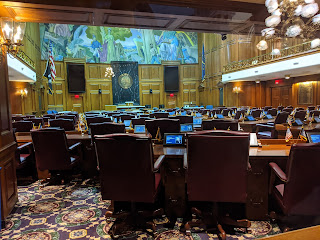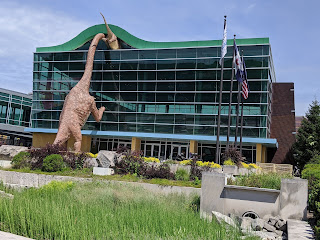When the Indiana Territory was established in 1800, the capital was Vincennes. The seat of government was moved in 1813 to the city of Corydon and it became the first state capital three years later when Indiana gained statehood. As settlers moved to the central part of the state, the state capital was moved yet again, this time to Indianapolis from Corydon.
By the 1860s, the first statehouse had deteriorated so badly that the limestone foundation had failed, the stucco had chipped off, and one of the ceilings had collapsed. That resulted in the old statehouse being demolished in 1877 and the new capitol was built in the same location. The current statehouse was completed in 1888 and featured a central copper dome.
After President Abraham Lincoln was assassinated, his funeral was held at the White House on April 19, 1865. His funeral train left two days later for Springfield, Illinois (a capital city we visited at almost the very end of this trip!) with stops en route to allow mourners to pay tribute. When the train reached Indianapolis at 7am on April 30th with Governor Oliver Morton on board, city buildings were draped in black.
Time Flow was commissioned to honor the Bicentennial of the State of Indiana. "The stainless steel ring represents a portal for the viewer to move from one point in time to another."
Not only is the statehouse the official meeting place for the state's elected officials, but it has also been the focal point for parades, private social gatherings, and protests, and to commemorate the deaths of notable Hoosiers, i.e. the residents of Indiana.
The current Indiana state seal wasn't made official until 1963. It had a representation of Indiana's territorial past including a woodsman cutting down a tree to 'civilize' the territory and a bison running freely. Note the sun shining on the new frontier. On the outer ring was a tulip leaf from the state tree.
The state seal was even molded into many dorknobs, including the governor's office door!
The old-style phone booths allowed for privacy when making cell phone calls - what a great idea in this age when we all overhear far too many 'private' calls!
Views from the third floor:
We could only peer through a window to see the Senate Chamber. I read that Indiana has a part-time legislature that is only convened from January-March or April every other year. The carpeting had motifs with a large star in the center surrounded by 18 smaller ones, indicating the state was the 19th to be admitted to the country. There are likewise 19 stars in the state flag.
The most striking room on the third floor was the Indiana Supreme Court which was largely unchanged from the way it looked in 1888. We just happened to be in the right place at the right time as a guard allowed me in to take a few photos before ushering us out!
By now if you've been following this blog, you know that Steven and I have traveled to quite a few state capitols. However, this was the first time we'd seen a Chair of Honor for prisoners of war and those missing in action so they wouldn't be forgotten.
We were sure getting our steps in, climbing to the fourth floor!
Abe, named by Indiana 4th graders, was the official mascot of the state's Bicentennial Celebration in 2016, also known as the bison-tennial!
One sculpture, known as The Living Monuments, celebrated the courage of living US veterans, nearly 400,000 of whom lived in Indiana.
This historic building was adjacent to Monument Circle.
From downtown Indy, we made our way to the Landmark for Peace Memorial. On the evening of April 4th, 1968, Senator Robert Kennedy had come to this space to address a large crowd of mostly Black Americans in his bid to be the Democratic Party candidate for the US president. Instead, he gave an impromptu speech announcing that Reverend Martin Luther King, Jr., had been assassinated that day in Memphis, Tennessee.
The words Kennedy spoke that night are as timeless for me now almost 53 years later:
What we need in the United States is not division. What we need in the United States is not hatred. What we need in the United States is not violence and lawlessness but is love, and wisdom, and compassion toward one another, and a feeling of justice toward those who still suffer within our country.
This panel marked the spot where Kennedy spoke and included part of his speech.
On April 4th, 2018, crowds again gathered in the same area to commemorate the 50th anniversary of Senator Kennedy's speech on Dr. King's assassination. Congressman John Lewis, RFK's daughter Kerry Kennedy, and state and local leaders participated in the 50th commemoration events.
How tragic that two such great men were taken from us. I wonder how the course of this country's history might have changed if their lives weren't cut so short by assassins' bullets.
The entire text of Kennedy's speech that sad evening is well worth reading. Just click on the photo to make it more legible.
What great fun it would be to take Max and Clara, our then almost newborn granddaughters, to the Indy Children's Museum someday as these photos were as close as we got! Notice the big mask on the dinosaur as a sign of the pandemic.
When traveling to new cities, Steven and I always like to search out city parks for walks and just get a sense of the city. Broad Ripple Park was pleasant enough and had a pretty view of the White River.
Next post: The National Museum of the Air Force near Dayton, Ohio.
Posted on January 31st, 2021, an almost springlike day here in Denver with bright blue skies and temperatures in the mid-50s that made it perfect for a walk in the morning with a friend and then in the afternoon with Steven. We are so blessed, if not spoiled, with the often mild Denver winters!



















































Thanks for including the full speech delivered by Robert Kennedy so many years ago; so much has changed yet stayed the same.
ReplyDeleteLina,
ReplyDeleteThat was exactly my thought about how little has really changed in all these years despite the heartfelt rhetoric to the contrary.